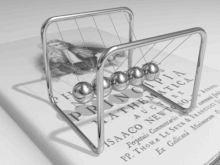Shot put pendulum

A shot put pendulum , also called a ball pendulum, Newton pendulum or Newton cradle , is an arrangement of identical elastic balls (mostly made of metal), each suspended in a row on two ( bifilar ) identical threads. Each ball forms a pendulum of the same mass and length and a given movement path. The distance between the suspension points in the frame is equal to the diameter of the balls so that they hang vertically and just touch each other.
If one of the outer balls is lifted laterally with stretched threads and falls back against the row of the other balls, the impact causes exactly one ball opposite to be repelled while the other balls remain at rest. If this ball swings back and hits, the impact repels the outermost ball on the other side - the system "swings".
The behavior with more than one moving ball is remarkable. If two or more balls hit the remaining balls, the same number of balls will be repelled on the other side as they hit the other side - and not just a single ball at higher speed, as one might suspect.
The behavior of the balls resulting from the terms of the conservation of momentum , combined with the conservation of kinetic energy .
The device goes back to the French physicist Edme Mariotte , who first published it in 1673 in his work Traitté de la percussion ou chocq des corps . It spread as a small, decorative toy from the 1960s onwards.
functionality
The ball at rest on the left in the picture on the left picks up the momentum from the impacting ball and transfers it to the ball on the right, and then to the ball on the right and so on. The ball furthest to the right, however, can no longer transmit any momentum and is repelled.
These are elastic collisions in which the kinetic energy and momentum are retained. Since no external forces act in the direction of movement during impact, the momentum of the balls of the mass , which hit the balls at rest from the left with the speed , must be equal to the momentum of the balls of the mass hit . If one also assumes that the balls hit collectively move to the right with speed , the conservation of momentum says:
Furthermore, the energy before and after the impact must be the same, neglecting the energy that goes into oscillations of the balls:
If you write this as
and if one takes into account the first equation, then, since it is not zero, the velocities are the same:
Then the first equation says that as many balls fly away as they hit.
Here it was assumed that the balls hit all move away at the same speed and the rest of them are at rest. With more than two spheres, one cannot infer that they do this from the conservation of energy and momentum.
If in the center of gravity system balls hit from the left with speed on balls with speed , whereby it is compatible with conservation of energy and momentum that after the hit balls move with speed to the right and balls move with speed to the left. But also balls with reversed speed and balls with speed are possible.
In order to explain the behavior of the ball chain, one has to consider more precisely how a shock wave runs through the chain. This was examined in 2014 by Kristof Heck and Simon Huppertz at " Jugend forscht " (2nd national winner).
literature
- F. Herrmann, P. Schmälzle: Simple explanation of a well-known collision experiment . In: Am. J. Phys. tape 49 , 1981, pp. 761 ff . ( physikdidaktik.uni-karlsruhe.de [PDF; 295 kB ]).
- F. Herrmann, M. Seitz: How does the ball-chain work? In: Am. J. Phys. tape 50 , 1982, pp. 977 ff . ( oebv.at ( memento of December 24, 2012 in the Internet Archive ) [PDF; 360 kB ]).
Web links
Individual evidence
- ↑ Kristof Heck, Simon Huppertz: Jugend-forscht 2014, Physics: Investigations on the shot put pendulum chain and on the Hertzian contact theory . ( mgm-monschau.de9 [PDF; 3.3 MB ; accessed on December 29, 2016]).
















